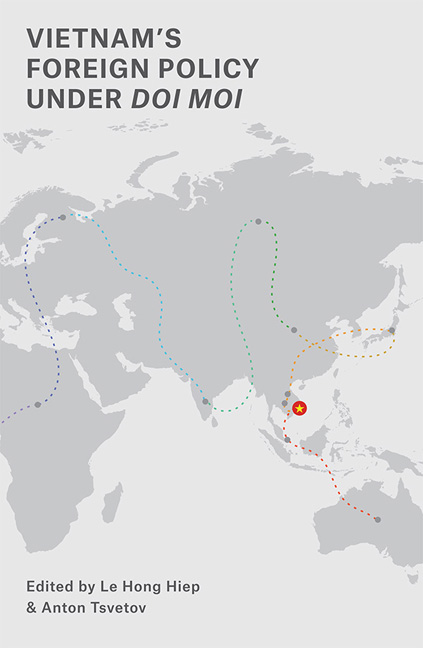Book contents
- Frontmatter
- Contents
- List of Tables
- List of Figures
- List of Abbreviations
- Acknowledgements
- About the Contributors
- PART I ANALYTICAL AND HISTORICAL FRAMEWORK
- PART II BILATERAL RELATIONSHIPS
- 3 The Evolution of Strategic Trust in Vietnam–U.S. Relations
- 4 The 2014 Oil Rig Crisis and its Implications for Vietnam–China Relations
- 5 Vietnam–Japan Relations: Moving beyond Economic Cooperation?
- 6 The Reinvigoration of India–Vietnam Partnership under Prime Minister Modi
- 7 Vietnam–Russia Relations: Glorious Past, Uncertain Future
- 8 Vietnam's Foreign Policy Towards its Smaller Neighbours
- 9 Vietnam's Decision to Join ASEAN: The South China Sea Disputes Connection
- PART III MAJOR FOREIGN POLICY ISSUES
- Index
9 - Vietnam's Decision to Join ASEAN: The South China Sea Disputes Connection
from PART II - BILATERAL RELATIONSHIPS
Published online by Cambridge University Press: 04 July 2018
- Frontmatter
- Contents
- List of Tables
- List of Figures
- List of Abbreviations
- Acknowledgements
- About the Contributors
- PART I ANALYTICAL AND HISTORICAL FRAMEWORK
- PART II BILATERAL RELATIONSHIPS
- 3 The Evolution of Strategic Trust in Vietnam–U.S. Relations
- 4 The 2014 Oil Rig Crisis and its Implications for Vietnam–China Relations
- 5 Vietnam–Japan Relations: Moving beyond Economic Cooperation?
- 6 The Reinvigoration of India–Vietnam Partnership under Prime Minister Modi
- 7 Vietnam–Russia Relations: Glorious Past, Uncertain Future
- 8 Vietnam's Foreign Policy Towards its Smaller Neighbours
- 9 Vietnam's Decision to Join ASEAN: The South China Sea Disputes Connection
- PART III MAJOR FOREIGN POLICY ISSUES
- Index
Summary
As the 1991 Paris Peace Accords brought an end to the Cambodian conflict, the normalization of Vietnam's relations with China appeared to be just a matter of time. Yet, China's seizure of the Paracels in 1974 and its encroachment into the Spratlys in 1988 continued to complicate the Sino–Vietnam relationship. Therefore, while trying to promote friendly relations with China, Vietnam remained vigilant and endeavoured to enhance its comprehensive national power to cope with the latter's territorial and maritime ambitions. Against this backdrop, some scholars argued that if Vietnam became an Association of Southeast Asian Nation (ASEAN) member, Hanoi could improve its strategic position vis-à-vis China as Beijing would have to deal with not only Vietnam, but also ASEAN as a whole (Johnston 2003, p. 28; Tuan 1994). It was therefore possible that Hanoi did have China in mind while pursuing ASEAN membership, which seemed to be even more sensible given the rising “China threat” thesis in the early 1990s (Betts 1995; Betts and Christensen 2000; Brown 1997).
This chapter, based on Vietnam's diplomatic archive and interviews with Vietnamese foreign policymakers and diplomats, traces thoughts of policymakers in Hanoi as to whether, while considering to join ASEAN, they were serious about enlisting ASEAN's support to bolster Vietnam's position in the South China Sea disputes with China. The chapter also examines if Hanoi viewed its bid for ASEAN membership as a measure to improve ties with the United States, thereby gaining leverage vis-à-vis China in the South China Sea.
The chapter contends that although the South China Sea disputes became an increasingly central security concern for Vietnam in the 1990s, Hanoi did not seriously consider its prospective ASEAN membership as a strategic tool to counter China's expansion in the South China Sea.1 This was because Hanoi realized that ASEAN was indeed not a military organization, and ASEAN members, as well as the United States, did not want to antagonize China by supporting Vietnam in the South China Sea disputes.
The chapter is divided into three sections. The first analyses shifts in Vietnam's perception of the China threat in the late 1980s and early 1990s when Vietnam was pursuing ASEAN membership.
- Type
- Chapter
- Information
- Vietnam's Foreign Policy under Doi Moi , pp. 186 - 208Publisher: ISEAS–Yusof Ishak InstitutePrint publication year: 2018

